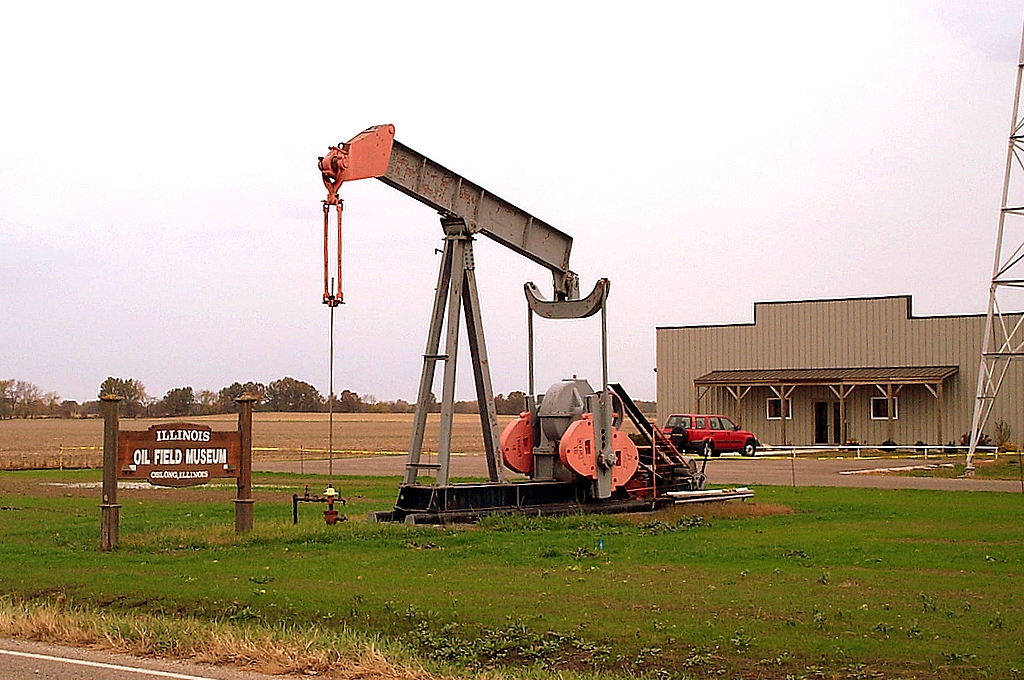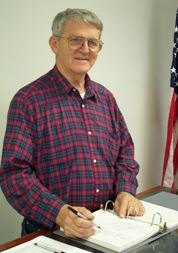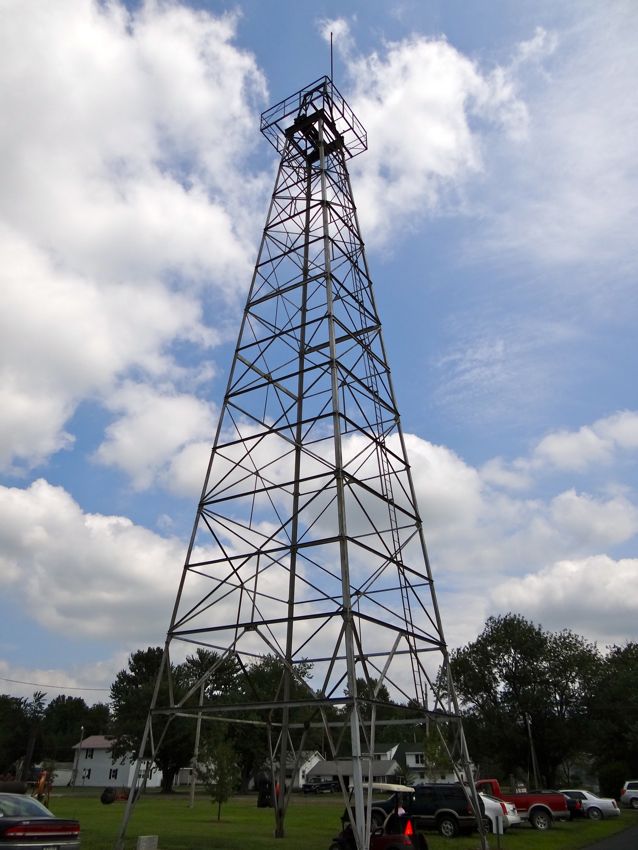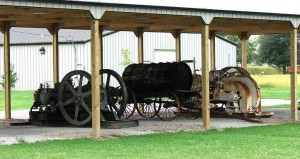Volunteers are key to Oblong museum’s exhibits and energy education events.
Building a community oil museum is not for the faint of heart. “Money and volunteers, volunteers and money,” are the biggest challenges, according to John Larrabee, board president for the Illinois Oil Field Museum and Resource Center on the outskirts of his hometown of Oblong, Illinois.

The Illinois Oil Field Museum is located in Oblong, Illinois, on Highway 33, southeast of Effingham. First opened in 1961, the museum moved into a new building in 2001. Photos by Kristin L. Wells.
“The first thing you have to have is a goal and the determination to keep at it, no matter what. Don’t give up, whatever happens,” Larrabee explained in a 2004 interview with Kris Wells, American Oil & Gas Historical Society volunteer researcher and contributing editor.
It helps to know something about the oil business, said the third generation Illinois Basin oilman. “The museum began way back in 1961 with a fellow named Enos Bloom, Larrabee noted. “In those days, the city of Oblong provided and maintained a building that housed donated artifacts.”

John Larrabee, a third generation Illinois Basin oilman, was responsible many of the museum’s renovations.
Bloom’s efforts were commemorated in a small monument adjacent to the former museum building. “Without the hardware and memorabilia that local producers’ contributed back then, there could never have been a museum,” Larrabee said.
Over the years, the original facility had deteriorated and the Oblong Oil Field Museum, as it was known at the time, faded as well. He regards the current building, completed in 2003, as one of the volunteer museum board’s great successes.
Oil Museum’s Rebirth
In 1989, efforts began to revive and invigorate the museum and it was reincorporated as the tax-exempt Illinois museum. “I have become a shameless fundraiser,” said Larrabee, who understands the critical necessity for grant money as well as corporate and individual donations.
With the support of former State Sen. Bill O’Daniel, the museum received a $100,000 grant from the state, making construction of the new building possible. The Illinois Petroleum Resource Board, Heath Foundation, Claypool Foundation, and Oblong Community Ruritan Club also provided much-needed funds.
Bradford Supply Company of nearby Robinson erected an “Old Oil Field Supply Store” annex to the museum, to house a variety of artifacts unique to the early days of the petroleum business.
Larrabee noted that continuing financial support will be necessary to ensure the museum can accomplish its mission “to preserve, collect, study, interpret, and exhibit significant materials relating to the Illinois Basin and surrounding areas of the oil boom era and the oil industry of that area.”
Because Illinois citizens’ tax dollars were used in construction, admission cannot be charged. The museum must find creative ways to raise funds – including a gift shop selling small bottles of oil from the historic Illinois Basin.

A 104-foot-tall derrick was donated to Oblong’s oil museum in 2001 by the Citation Oil Company, Houston, Texas. It came from the nearby Salem field, discovered in 1938.
Illinois Basin Oil Boom
In March 1906, the Shire No. 1 discovery well was shot with nitroglycerin and blew in as a 2,500 barrel a day gusher just east of where the museum stands today. The story goes that three men from Pennsylvania had leased a bunch of land in the area, but didn’t know where to drill.
With a couple of female companions and a bottle of whiskey, they set off on a buckboard, determined that when the bottle was empty, they would throw it over their shoulders and drill where it landed. They did and the Shire No. 1 became the discovery well for the Crawford County oil boom.
In 2001, with a $7,500 grant from the Heath Foundation, the museum purchased almost an acre of pasture surrounding the long-abandoned Shire No. 1 well.
Volunteers erected a 52-foot replica of the original wooden derrick, but for safety, state regulators required the old borehole be properly plugged with a deep cement injection. This process caused the well to yield up several rare gallons of oil — quickly scooped up to find its way into small souvenir bottles to sold by volunteers at the museum.

Crawford County’s first of many oil discoveries arrived in March 1906. The Shire No. 1 well was shot with nitroglycerine and initially produced 2,500 barrels of oil a day.
Oblong’s population of only about 1,600 does not provide a very large reservoir of volunteers. “All the board members are working folks,” said Larrabee, “Don Bertham and myself are still oil producers, Della Workman is an officer at the Bank, and so on.”
Dedicated Volunteers
When Citation Oil Company of Houston donated the 104-foot derrick that stands outside the museum, few hands were available to wield the paintbrushes. Like most community museums, the Illinois Oil Field Museum is always on the lookout for volunteers.
“I’m a big advocate of publicity,” says Larrabee, who works with the “Oblong Gem” and “Robinson Daily News” to keep the museum in the public eye. Indiana’s WHTI TV Channel 10 sent a crew from Terre Haute to cover the festivities when the Citation Oil Company derrick was completed. The annual Oblong Antique Tractor and Engine Show draws about 10,000 visitors.

In addition to equipment displays, the Illinois Oil Field Museum hosts events to raise awareness about the petroleum industry.
“We just had our annual ‘Oil Field Appreciation Day’ and ‘Old Timers Reunion’” said Larrabee. Such events are key to raising public awareness and encouraging volunteers. He has encouraged events to bring visitors to southeast Illinois, the city of Oblong, and the Illinois Oil Field Museum.
Southwest of Terre Haute, Indiana, and southeast of Effingham, Illinois, the town of Oblong on Highway 33 is surrounded by scenic farmland. Travelers on the road see numerous low-production “stripper” wells pumping oil.
The Oblong museum exhibits new and historic petroleum technologies thanks to dedicated volunteers like John Larrabee and his associates, who maintain a unique museum to preserve the Illinois Basin’s oil and natural gas legacy.
_______________________
Recommended Reading: Illinois Oil and Gas. Images of America (2023). Your Amazon purchase benefits the American Oil & Gas Historical Society. As an Amazon Associate, AOGHS earns a commission from qualifying purchases.
_______________________
The American Oil & Gas Historical Society preserves U.S. petroleum history. Become an AOGHS annual supporting member and help maintain this energy education website and expand historical research. For more information, contact bawells@aoghs.org. © 2023 Bruce A. Wells.
Citation Information – Article Title: “Illinois Oil Field Museum.” Authors: B.A. Wells and K.L. Wells. Website Name: American Oil & Gas Historical Society. URL: https://aoghs.org/energy-education-resources/illinois-oilfield-museum. Last Updated: June 25, 2023. Original Published Date: December 1, 2004.


